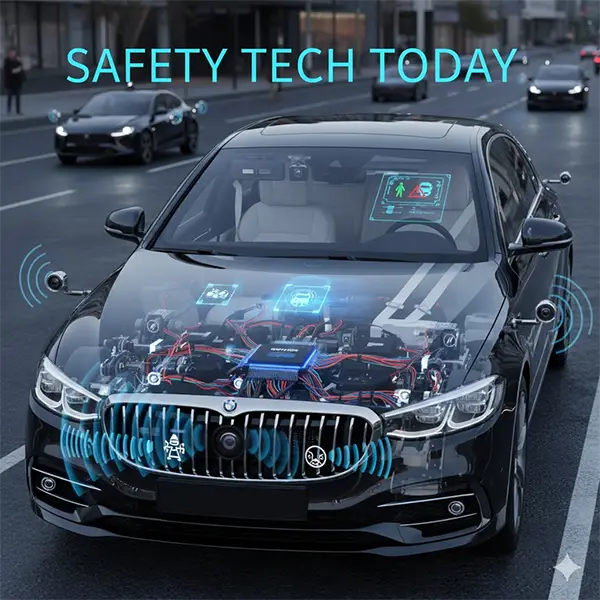
“Today’s cars aren’t just vehicles – they are smart safety machines that can predict dangers, prevent accidents and drive better on your behalf”.
These advanced vehicles with ECS (electronic stability control) lower fatal single-vehicle crashes by 69% for cars and 88% for trucks and vans. (Source: NHTSA)
And has given a strong boost to the smart automobile market – “The global ECS system market was about US $ 36.71 billion in 2022 and this tech spike has projected it to reach US $ 83.82 billion by 2030, showing a CAGR of 10.9%”. (Source: FBI)
Many features that were once optional, illegal and luxurious are now standard and legally requires. The major safety tech has advanced in today’s automobiles.
Continue reading to see how these systems prevent real-world accidents and why they matter more than ever.
Most modern cars are now available with mandatory foundation systems including – Anti-lock braking system (ABS), airbags, electronic stability control (ECS), rear cameras, ISOFIX mounts and TPMS and child safety seats.
The basic but essential safety gear helps to prevent accidents and reduce damage.
Advanced systems now aim to protect one level above crash – by proving to avoid a collision altogether.
These systems are like an active servant watching dangers and making your drive perfect.
An estimation of 17.6% fatal vehicle crashes in the U.S. between 2017 and 2021 involved a drowsy driver. (Source: AAA Foundation) This is a very common situation for many accidents.
Understand this with a real-life incident:
Case Study
Aman, a sales manager from Pune, was driving late from a 14-hour shift. He was very tired but still felt ‘okay to drive’ and drove. A few minutes later, he took a short nap and the car started drifting beside the lane. The cameras detected this, slowed the car and alerted Aman immediately. Aman admitted – ‘It was the car that saved his life’.
Today’s cars don’t just warn you – they help you.
The adaptive cruise lane keeping gently keeps you back on right track after a drift and parking assist takes control to manage space in tight spots. Hill start prevents rollbacks and traffic-jam assist smoothens the stop and go chaos.
They don’t just take control, they reduce mental tasks and keep you calm.
With radar for speed, ultrasonic sensors to detect objects, 360° cameras for full view, LiDAR maps for accuracy and V2V communication for exchanging data – cars stay updated about their surroundings and keep you updated with safe and smooth driving.
These sensors are like multiple senses – vision, hearing and situational hearing, fused altogether.
Pro-Tip
Driver assistant features should be on. They will allow you to focus more on the road while handling small and repetitive tasks in the background.
Not every feature is there to avoid accidents – some are about making your drive smooth and lighter.
These alerts are like a calm and cautious friend in the backseat – so you drive relaxed and focused.
Car safety has shifted from just protection to smart prevention. Modern vehicles don’t just depend on airbags and ABS – they use AEB, cameras, radar and AI to react faster than humans. Resulting in fewer accidents and safe rides!
They don’t replace skills, they strengthen them by spotting risks before you and fixing them in milliseconds. Still, if you unfortunately get into an accident, it is best to consult an injury lawyer to navigate all the legal proceedings smoothly.
“Modern cars don’t wait for danger – they work to prevent it.
No, they manage repetitive tasks, allowing drivers to put more focus on the road.
No, assisting features support you while giving you full control of the car.
It’s very rare for these systems to fail and they are designed with backups.
In these serious cases, it’s wise to consult an injury lawyer to claim your rights.
